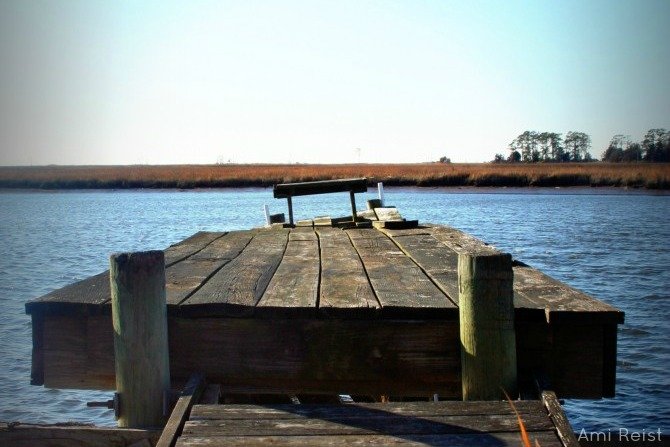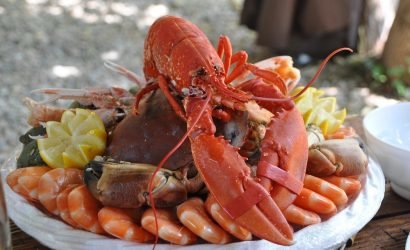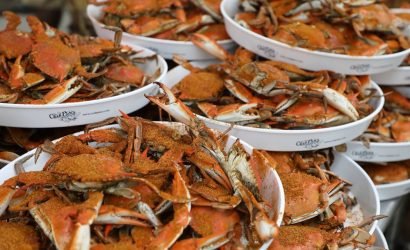I’m not sure what I was expecting to see when I had planned my Sunday trip to Deal Island Wildlife Management Area, west of Princess Anne, MD. I know that I had hoped to see some wildlife – a deer or two, some birds flying overhead, oysters in the marsh – the usual Eastern Shore suspects.
I drove along the twisted and winding, single-lane road under the branches of slowly swaying trees directly towards the marsh. If it weren’t for my eyes quickly noticing the yellow road sign that read “Road Ends” only 15 feet from where the Manokin River swallows the paved driveway, my car may have been in the icy waters. Deal Island Road runs the entire length of the park. During my entire visit to the island, I only spotted one other vehicle (parked where the Manokin River meets the land of the Wenona area), and one man (who was completely bundled up), walking the edge of the road through the park. I’m assuming the chilly winds and temperature high of 36 degrees kept most people away. Being my first visit, for all I know, it could always be this desolate.
For covering over 13,000 acres of tidal marshland, forested wetlands, open waters, and a man-made pond, I saw an unamusing amount of wildlife. I had read articles about the large numbers of uncommon waterfowl that call the island home: egrets, ibis, black-necked stilts, and wigeons. Many Eastern Shore frequents like morning doves, Canadian geese, mallards, crows, and black vultures were noticed.
There are many interesting breeds of waterfowl that call Deal Island home over the winter months. The Eurasian wigeon is a duck that frequents the salt marshes, nests in the sea grasses, and spends the entire winter on the coast. Other uncommon winged-creatures often noted on the island include pintails, gadwalls, teals, and shovelers. Not only is Deal Island typically a birders paradise, it’s also exciting for bird-watchers of different sorts: hunters.
Hunting is allowed in accordance with open hunting seasons and shooting hours. There are designated regulations and requirements for hunters who are permitted to hunt in the Wildlife Management Area. Certain areas of the impoundment, reserved for waterfowl refuge and breeding, are not designated as hunting land.
The hunting areas are part of Maryland’s Department of Natural Resources public land system. The whole purpose of the Wildlife Management Area is to conserve and amplify wildlife populations and their habitats. The area also provides open recreational use of wildlife resources.
Just last month, portions of Deal Island were closed by the Department of Natural Resources because something questionable was discovered. It had been brought to state attention that illegal bait was being distributed on the reserve to attract waterfowl to the area. After a temporary closure, hunting was permitted again.
This isn’t the first seedy operation that’s happened on Deal Island. Rumor has it that Deal Island was once the perfect hideout for local pirates. Pirates on the Eastern Shore? You bet so. In the 1700’s, pirates would attack and rob trade ships traveling to big cities that line the Chesapeake. Merchandise from colonial cities like Baltimore was found on Deal Island, where the pirates would retreat to, because it was a land of solitude.
As of last weekend, there was no need to worry about baited hunting ponds or pirates. Currently, Deal Island is an outdoor enthusiast’s joy. There are fields to hustle through, birds to be seen, forest trails to hike, places to launch a kayak or canoe, more hunting than you could imagine, and fishing, too.
Even though I didn’t see the exact wildlife I had hoped to see while visiting Deal Island last weekend, I’m sure I’ll visit again. The place could look much different during the spring and summer months. I’ll have to pick up a hiking trail map and follow it closely. There are some small yellow and blue trail maps to denote public access ways, but they seem to get lost in the trees.
When I make the slightly lengthy drive down Route 13 next, I hope to see at least one wigeon, one pintail, and one shoveler flying from branch to branch in the beautiful woods or scooping over the yellowed marshland.
If you visited, Deal Island Wildlife Managment Area this winter, tell us what you saw!








